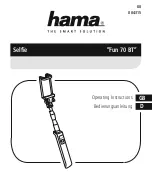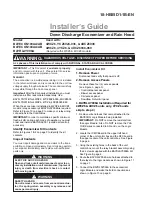
5
E3T-C
Safety Precautions
Refer to
Warranty and Limitations of Liability
.
This product is not designed or rated for ensuring
safety of persons. Do not use it for such purpose.
Do not apply AC power to the E3T, otherwise the E3T
may rupture.
Do not use the product in atmospheres or environments that exceed
product ratings.
Wiring
The maximum power supply voltage is 26.4 VDC. Before turning the
power ON, make sure that the power supply voltage be not more than
maximum voltage.
Load short-circuit protection
The E3T incorporates a load short-circuit protection function. If the
load short-circuits, the output of the E3T will be turned OFF. Then,
recheck the wiring and turn on the E3T again to reset the load short-
circuit protection function. The load short-circuit protection function
will work if there is a current flow that is 1.5 times larger than the rated
load current. When using a capacitance load, be sure that the inrush
current will not exceed 1.5 times larger than the rated current.
Mounting
When mounting the Sensor, never strike it with a heavy object, such
as a hammer. Doing so may reduce its watertight properties. Use
screws with spring, flat, or toothed washers to secure the Sensor.
Tightening Torque
Small Cylindrical Sensors: 1 N·m max
Mounting the Sensor on Moving Parts
Consider models that use break
resistant cables (e.g., Robotics
Cables) if the Sensor will be
mounted on a moving part, such as a
robot hand. The flexing resistance of
Robotics Cable at approximately
400 thousand times is far superior to
that of standard cable at
approximately 14 thousand times.
Cable Bending Rupture Test
(Tough Cable Breaking Test)
The cable is repeatedly bent with
power supplied to check the number
of bends until the current is turned
OFF.
Adjusting
Indicators
The following graphs indicate the status of each operating level.
Be sure to use the E3T within the stable operating range.
E3T-CD
@@
Sensitivity Adjustment
Use the special screwdriver that is provided with the Sensor to adjust
the sensitivity. Do not exceed 0.8 N·m when turning the adjuster.
Others
Do not install the E3T in the following locations.
Locations subject to excessive dust or dirt
Locations subject to direct sunlight
Locations subject to corrosive gas
Locations subject to contact with organic solvents
Locations subject to vibration and shock
Locations subject to contact with water, oil, or chemicals
Locations subject to high humidities that might result in
condensation
WARNING
Precautions for Correct Use
Specimen
Standard cable
2.4-mm dia.
(7/0.127-mm dia.),
3 conductors
Robotics cable
2.4-mm dia.
(20/0.08-mm dia.),
3 conductors
Test
Con-
tents/
condi-
tions
Bending angle (
)
90
each to the left and right
Bending speed
50 times/min
Load
200 g
Operation per bend
Once in 1 to 3 in the diagram
Curvature radius of
support point (R)
5 mm
Result
Approx. 14,000 times
Approx. 400,000 times
θ
θ
Weight
R
A
C
B
S
t
ab
le
oper
a
tion
r
a
nge
*
Un
s
t
ab
le
oper
a
tion
r
a
nge
*
S
t
ab
le
oper
a
tion
r
a
nge
*
Oper
a
ting
level x 1.2
Oper
a
ting
level
Oper
a
ting
level x 0.
8
Light
ON
ON
ON
ON
OFF
OFF
OFF
S
t
ab
ility
indic
a
tor
(green)
Oper
a
tion indic
a
tor (or
a
nge)
E
3
T-
@@@
1
E
3
T-
@@@
3
E
3
T-
@@@
2
E
3
T-
@@@
4
*
If the E
3
T f
s
oper
a
ting level i
s
s
et to the
s
t
ab
le oper
a
tion r
a
nge, the
E
3
T will
b
e in mo
s
t reli
ab
le oper
a
tion witho
u
t
b
eing infl
u
enced
b
y
temper
a
t
u
re ch
a
nge, volt
a
ge fl
u
ct
ua
tion, d
us
t, or
s
etting ch
a
nge. If
the oper
a
ting level c
a
nnot
b
e
s
et to the
s
t
ab
le oper
a
tion r
a
nge, p
a
y
a
ttention to environment
a
l ch
a
nge
s
while oper
a
ting the E
3
T.


























